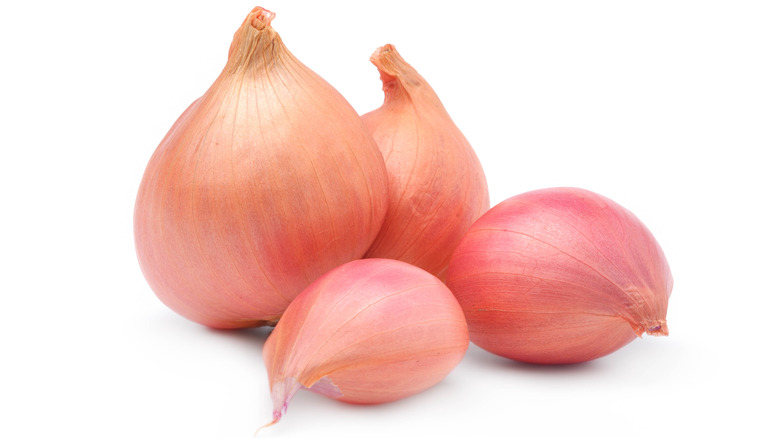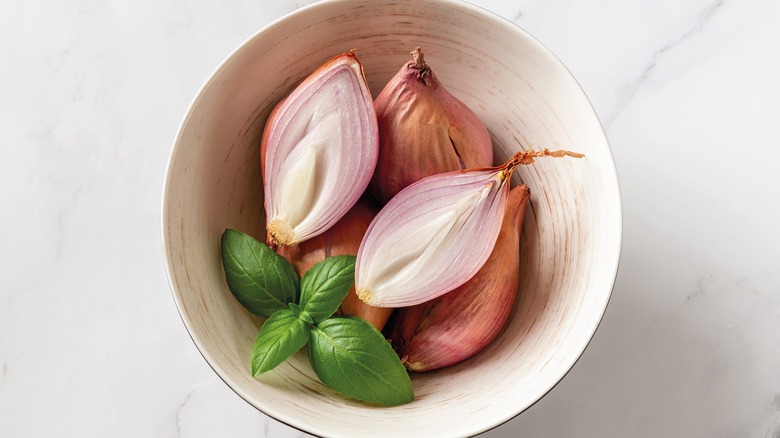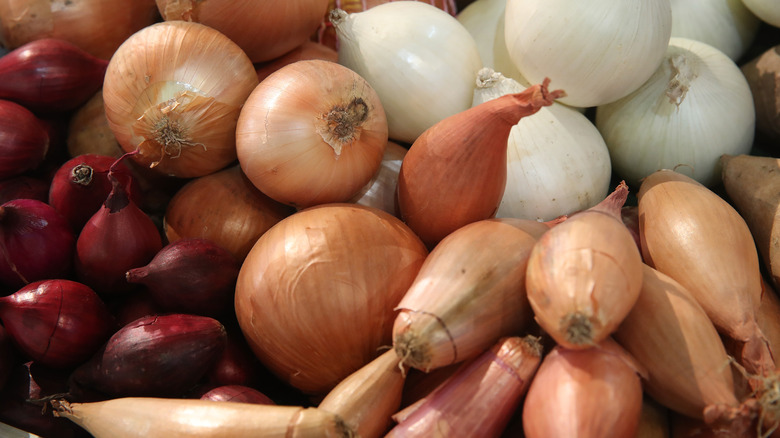How Did Shallots Get Their Name?
To quote William Shakespeare, what's in a name? That which we call a shallot by any other name would taste just as sweet. Well, there is a bit of history in this name, but there's no denying the Bard; shallots are indeed fairly sweet yet also a bit spicy.
Raw shallots, per Food Network, lead with pungency and then leave a mild aftertaste. Cooking and therefore caramelizing them accentuates their sweet potential, allowing chefs to flavor dishes with richness. Varieties of the veggie include the French Grey, which is common at restaurants, and Jersey shallots, which more often end up in the kitchens of home cooks. Either way, they look like little, stretched-out onions (making them a bit tricky to cut) covered in a layer of dark purplish skin with reddish-white cloves underneath. As noted by BBC Good Food, they require cool, dark, and dry storage, and need to be trimmed, peeled, and sliced for most culinary applications, like frying or roasting.
After such preparations, shallots often find their way into casseroles, salads, sandwiches, sauces, soups, stews, and stocks. If you plan to do some cooking with them, there are a few things you should look out for when buying shallots at the store. But how did this alluring allium get its name?
Shallot has an ancient etymology
The word "shallot" actually refers to more than one thing. Per Merriam-Webster, green onions — bulbs harvested prior to enlargement — are sometimes called shallots. Although shallots are related to onions, more accurately, "shallot" refers to the perennial that's scientifically named Allium cepa aggregatum, the same veggie discussed above.
As mentioned by the Food Network, such shallots have long been used in Asian and Middle Eastern cuisines. In fact, according to PasseportSanté, the shallot shares a home with those cultures and is believed to have originated somewhere near Turkestan before spreading to the Mediterranean, the Near East, and South-West Asia in ancient times. As such, it's naturally gone by many different monikers over the ages.
It's been said ancient Greeks gave shallots their name when Greek merchants first came across the crop in Ascalon, a Palestinian port city (via the National Center for Biotechnology Information). Another story claims crusaders named shallots, introducing them to Europe from Ascalon in the 11th century. Merriam-Webster spells things out a bit more: the Latin term "ascalonia caepa" translates to "onion of Ascalon." That phrase was informally shortened in Latin to "escalonia," which became "eschalotte" in French. Take off the e's at the beginning and end of "eschalotte" and you can start to see how this word ended up where it did. Whether the Greeks or crusaders started it, two things seem certain: Latin was involved somehow and Ascalon was the original inspiration.
Shallots share history with onions
Notice how the original European name for shallots referred to them as the onion of Ascalon? As mentioned, shallots are indeed related to onions. In fact, as noted by the University of Missouri, shallots technically are a type of onion, and we don't just mean the previously discussed green onion (etymology and taxonomy can be confusing). "Onion" is a term that broadly denotes the Allium genus, including common onions, garlic, leeks, and scallions. Fun fact: The word "onion" is related to the Latin term "unio," since onions consist of a single bulb containing many concentric rings.
This vegetal family dates back at least 5,000 years to Central Asia and, according to the National Onion Association, was probably a staple of prehistoric diets, predating writing, and even agriculture. Bronze Age societies developed alongside the onion, cultivating it not only for food but also to use as folk medicine and for religious purposes. In Medieval times, people also used onions to pay rent and gave them away as wedding gifts. At some point, the onion — including scallions — made it to the New World and became ubiquitous. Onions might not be as revered as they once were, but they're still eaten by many and continue to be used for health purposes, too.
So, what's in a name? In the case of shallots, a lot! Their roots run deep and, although they literally grow in the ground, their figurative family tree is a proud one.


